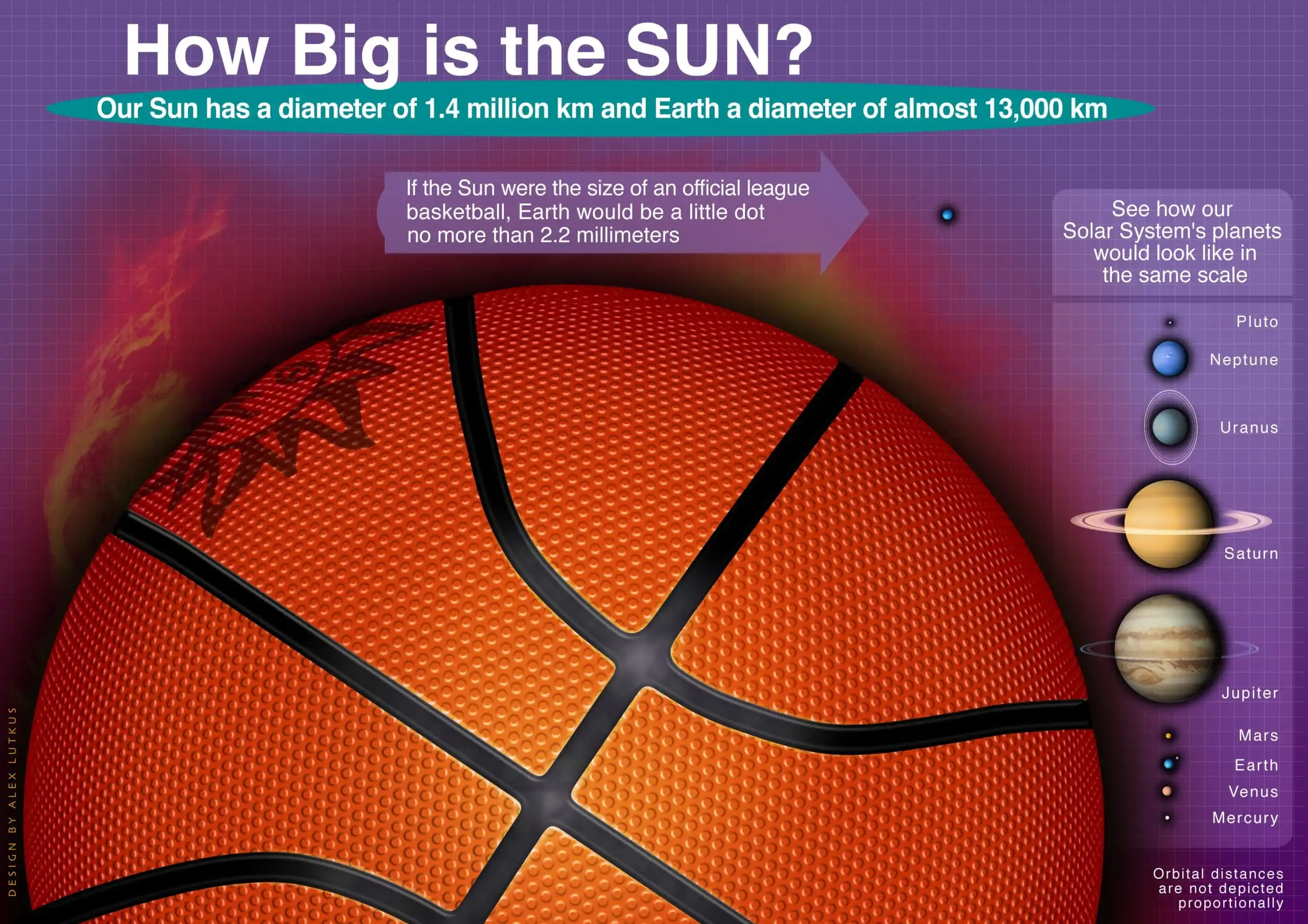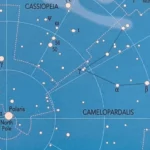Picture this: traveling to the stars, exploring the great wide open beyond our own planet. Ready yourself for a journey to our cosmic neighbor, the Sun. While we’ve all seen it in the sky, let’s take a closer look and see how it stacks up against our own home planet, Earth. Spoiler alert: it’s going to make you feel a bit smaller in the grand scheme of things!
How Big is the Sun Compared to the Earth?
Have you ever wondered just how much bigger the Sun is than our home planet?
Well, let’s put it this way: if the Earth was the size of a grape, the Sun would be bigger than a basketball! Yes, that’s right; the Sun’s diameter is a whopping 109 times that of the Earth. If you lined up 109 Earths end-to-end, they would stretch the distance from the Earth to the Moon and back!
But it’s not just the width of the Sun that’s impressive. Its volume? A staggering million times that of the Earth. That means you could fit a million Earths inside the Sun with room to spare!
And then there’s the mass. The Sun weighs in at 330,000 times the mass of the Earth. Imagine trying to lift 330,000 Earths!
All this mass and volume give the Sun its incredible gravitational pull, which keeps Earth and the other planets firmly in orbit around it. In a nutshell, the Sun is a truly cosmic giant, dwarfing our planet in every dimension.
Looking to understand the vastness of our solar system? Explore the mind-boggling scale of the sun by discovering how many Earths can fit inside it. Uncover the celestial mechanics behind the sun’s creation and its significance in space. Dive into the captivating world of astronomy and expand your knowledge with our comprehensive articles.
How many Earths could fit inside the Sun?
Have you ever wondered how many of our tiny planet Earth could fit inside the massive Sun? It’s like comparing a tiny marble to a giant beach ball!
Well, get ready to be amazed because scientists have done the math, and the answer is a whopping 960,000! That’s right, nearly a million Earths could fit snugly within the Sun’s enormous belly.
How is that even possible, you might ask? The Sun is colossal! Its diameter alone is 109 times bigger than Earth’s, stretching an unbelievable 1.39 million kilometers from one side to the other. Earth, on the other hand, is a mere 12,742 kilometers across.
So, if you lined up 960,000 Earth-sized spheres inside the Sun, they’d fill it up quite cozily. Imagine a giant celestial pinball machine, with Earth-sized balls bouncing around in the fiery depths of the Sun.
Of course, the Earth isn’t a perfect sphere, so it wouldn’t fit perfectly into the Sun. But even if we squeezed them in as tightly as possible, we’d still have plenty of room to spare in the Sun’s spacious interior.
This awe-inspiring size difference shows us just how small we are in the grand scheme of things. But it also reminds us of the Sun’s immense power and importance. Its gravity keeps us in orbit and protects us from harmful cosmic rays, making it the life-giving force that nurtures our planet.
Why is the Sun so much larger than Earth?
The Sun stands as a cosmic behemoth, a celestial giant that dwarfs our tiny planet Earth. But what makes the Sun so incredibly massive? Let’s dive into the mysteries behind its colossal size.
Imagine a humongous pile of 1.3 million Earth-sized spheres – that’s essentially the volume of the Sun! It’s no wonder we humble Earthlings feel like microscopic specks under its radiant gaze.
The Sun’s gargantuan size can be attributed to several factors. First and foremost, its composition is vastly different from Earth’s. While our planet is a solid body made of heavy elements, the Sun is primarily composed of lightweight gases like hydrogen and helium. This gas-filled nature significantly contributes to its immense volume.
Another essential factor is gravity. The Sun’s massive gravitational pull acts like an invisible force, pulling its gases inward. This compression creates a tremendous amount of pressure and heat at the Sun’s core, triggering nuclear fusion reactions. These fusion reactions power the Sun’s brilliance and warmth, reinforcing its vast size.
Key Points:
- Lightweight gases make up the Sun’s composition, contributing to its large volume.
- Gravity compresses these gases, generating high pressure and temperature at the Sun’s core.
- Nuclear fusion reactions, fueled by these intense conditions, sustain the Sun’s size and energy output.
How does the size difference between the Sun and Earth affect our planet?
The Sun is a huge star that’s much bigger than our Earth. It’s so big, that over 100 Earths could fit side-by-side across the Sun. This incredible size difference has a lot to do with how our planet works.
The Sun’s Powerful Pull
Because the Sun is so big, it has a lot of gravity. Gravity is a force that pulls things towards each other. The Sun’s gravity is what keeps Earth and other planets in our solar system orbiting around it. Without the Sun’s gravity, Earth would be drifting around in space.
A Constant Source of Energy
The Sun is also a giant source of energy. It’s like a giant nuclear reactor that’s been burning for billions of years. This energy comes in the form of sunlight, which travels to Earth as waves of light.
Sunlight is essential to life on Earth. Plants use it to make food, and it’s also what makes Earth warm enough for us to live on. Without the Sun, Earth would be a very cold, dark place.
Keeping Us in Balance
The Sun’s size and energy output are just right for supporting life on Earth. If the Sun were any bigger, it would be too hot for us to live. If it were any smaller, it wouldn’t be able to provide enough warmth and light.
The Sun is a crucial part of our solar system, and its size and energy output have a huge impact on our lives. It’s something we often take for granted, but it’s essential for all life on Earth.
Key Points:
- The Sun is over 100 times larger than Earth in diameter and 1.3 million times larger in volume.
- The Sun’s gravity keeps Earth and other planets in orbit.
- Sunlight from the Sun provides energy for plants and makes Earth warm enough for life.
- The Sun’s size and energy output are essential for supporting life on Earth.
FAQ
Q1: How does the Sun’s size compare to Earth’s?
A1: The Sun is vastly larger than Earth, with a diameter approximately 109 times that of Earth’s. Its volume is over 1 million times that of Earth, and if the Sun were hollow, more than a million Earths could fit inside it.
Q2: What is the difference in mass between the Sun and Earth?
A2: The Sun’s mass is approximately 330,000 times that of Earth’s. This means that the Sun’s gravitational pull is far stronger than Earth’s, keeping all the planets in our solar system in orbit around it.
Q3: How large would the Sun appear in the sky if it were the same distance as the Moon?
A3: If the Sun were the same distance as the Moon, it would cover the entire sky and appear much larger than it does now. This is because the Sun is much larger than the Moon, despite being much further away.
Q4: How many Earths would be needed to fill the Sun’s volume?
A4: Approximately 1.3 million Earths would be needed to fill the Sun’s volume. The Sun’s vast size and mass make it the dominant body in our solar system, controlling the orbits of all the planets and shaping the conditions on Earth.
Q5: What would happen if the Sun were smaller or larger?
A5: If the Sun were smaller, it would emit less heat and light, potentially making Earth too cold for life to exist. If it were larger, it would emit more heat and light, potentially making Earth too hot for life to exist. The Sun’s size and stability are crucial for the survival of life on Earth.
- Unlock Filipino Culture: A Deep Dive into Traditions and Practices - April 23, 2025
- Unlock Spanish Culture: Insights & Opportunities Now - April 23, 2025
- White Spirit Uses & Substitutes: A Deep Dive for Pros & DIYers - April 23, 2025
















